The Two-Inch Nightmare Snow Storm That Brought Down Atlanta
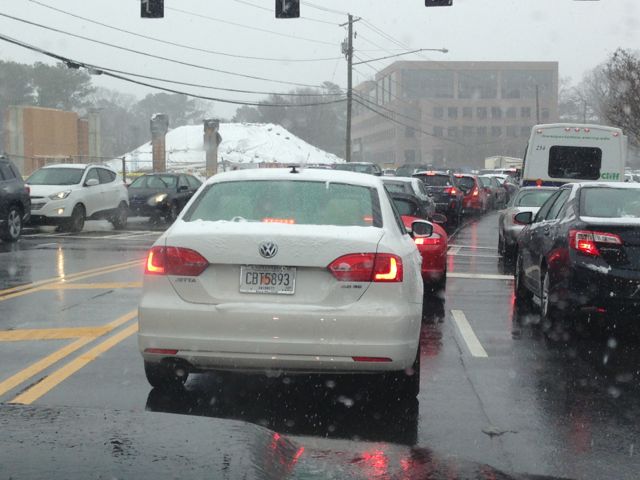
I was one of the lucky ones. I spent only two hours in my car when the big snow storm of 2014 hit Atlanta on Tuesday. We got only about 2″ of snow in my part of the city, but I made the mistake of going out for lunch at a restaurant right next to Emory University and the CDC compound. It took Jeffrey and me an hour and 45 minutes to drive the 2 miles back to the office. In the photo below, you can see that the roads themselves were still in good shape at 2 o’clock, at least where we were.
I was one of the lucky ones. I spent only two hours in my car when the big snow storm of 2014 hit Atlanta on Tuesday. We got only about 2″ of snow in my part of the city, but I made the mistake of going out for lunch at a restaurant right next to Emory University and the CDC compound. It took Jeffrey and me an hour and 45 minutes to drive the 2 miles back to the office. In the photo below, you can see that the roads themselves were still in good shape at 2 o’clock, at least where we were.
While I was sitting there in the passenger seat, I decided to take a look at the rest of Atlanta traffic. Here’s what it looked like at 1:45 pm, near the beginning of our sojourn. Then it got worse.
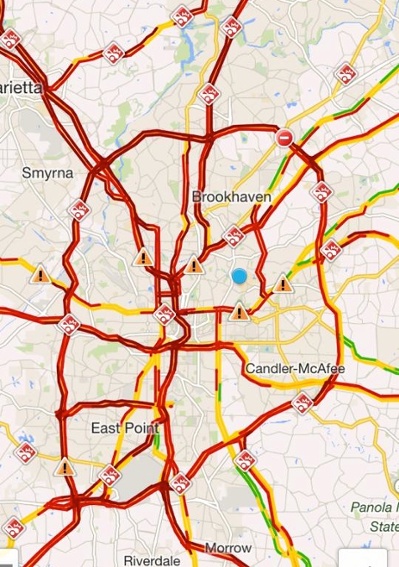
The good news, though, was that the grocery store near our condo was still fully stocked with milk. I’m actually a little disappointed in our neighbors for allowing this to happen and hope they show the appropriate level of panic next time.
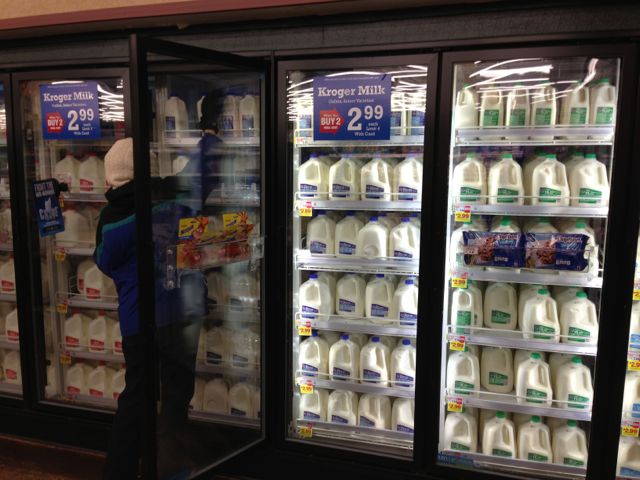
What happened?
If you’ve paid any attention to the news, you’ve heard plenty of horror stories about the tremendous pain caused by a meager two inches of snow. One woman couldn’t get to the hospital so she gave birth to her new baby in her car, stuck on I-285 (the Perimeter). Kids were stuck in school buses till late at night, or even overnight. There were 1254 accidents in a 24 hour period. And on and on…
The basic facts are that everyone went about their lives as usual on Tuesday. Adults went to work and kids went to school. The snow started coming down around noon. All the schools and many workplaces released everyone to go home at about the same time. The roads gridlocked quickly. The snow hit the roads, melted, and then froze into ice.
The government bodies in charge—and there are many, with over 60 mayors of cities and towns in the metro area—didn’t pretreat the roads. People here don’t have snow tires or chains, for the most part. The result was abysmal driving conditions, leading to all the accidents and even more gridlock.
Why we melted down in the big freeze
Plenty has been written about it already, and you can read some good analysis in this article in The Atlantic as well as this article in Politico Magazine. Yes, the school districts could have helped to avert the nightmare by canceling school in advance. The governments could have pretreated the roads. People could have stayed home from work. The problem is actually deeper than that, but why didn’t anyone do those simple things anyway?
Some people have blamed the meteorologists, saying weather reports were calling only for flurries in Atlanta with most of the snow going to the south of us. That’s not what I saw. I get my weather news from the Weather Channel app on my phone, and it had been calling for snow two days in advance. What they were forecasting 24 hours ahead is exactly how it played out. Still, despite our governor blaming bad weather reports, the problems go deeper.
Edited to add: The National Weather Service did get it right. The American Geophysical Union published an article today showing that we were under a Winter Storm Watch starting at about 5 am on Monday. They upgraded the Winter Storm Watch to a Winter Storm Warning at 3:39 am on Tuesday, with a prediction of 1 to 2 inches of snow. The problem wasn’t a lack of warning from the weather forecasters.
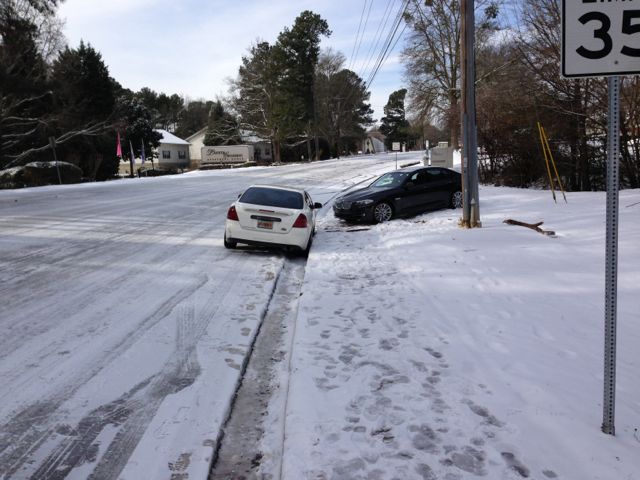
Yeah, it definitely could have been handled better to mitigate the trauma we experienced this week. The root cause, however, is suburban sprawl with almost no alternatives to getting around by automobile. We have MARTA, with its sparse heavy rail and its buses. I use the train when I go to the airport, but it’s difficult to live here without relying pretty heavily on your car.
When the MARTA rail lines were built, some of the suburban counties rejected having them extend out to their areas. In 2012, we had a statewide referendum on approving new tax money to fund transit projects that could provide alternatives to cars. Voters rejected it by a large margin.
Yes, weather forecasts and bad decision-making affected the results. Better long-term planning could have had millions of people safely at home instead of sleeping on grocery store floors, in churches, or in their cars. The drive-till-you-qualify housing market lets people have bigger houses, but at a cost.
Will we learn our lesson?
It remains to be seen if this will be a tipping point for us. I’m a bit skeptical because our state government prefers funding highways over public transportation. I’m sure we’ll hear some calls for more lanes and more roads as a solution, but we probably would have seen pretty much the same thing on Tuesday even if we’d had double the amount of roads.
But there is hope! The Atlanta Beltline, shown in the map above, is ramping up and offers some relief, at least in some areas of the city. The Beltline includes transit-oriented development, light rail, trails, and parks. It’s a really cool project, dreamed up by a Georgia Tech student in 1999. We need more of this kind of planning!
This just in!
Evidently the snow-induced gridlock brought out the snow predators, too. I’m sure this guy has a full belly now.
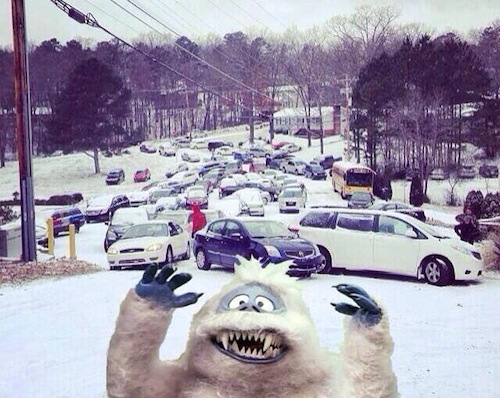
Seriously, though, one of the great things that comes out of a nightmare like this is hearing about the people who went out of their way to help others. I saw a photo of a man passing out snacks to people stuck in traffic. Many people helped push cars and try to get them unstuck. Businesses and organizations opened their buildings to stranded commuters. Teachers calmed their students by treating the event as an adventure.
I grew up in the ’60s and loved to watch Mr. Rogers on TV. The stories of the helpers remind me of something he said: “When I was a boy and I would see scary things in the news, my mother would say to me, ‘Look for the helpers. You will always find people who are helping.'”
Related Articles
More Important than Home Energy Efficiency – Location Efficiency
An Elderly Couple in Maine Offers to Trade Their Car for Fuel Oil
Has the Long Emergency Begun? Peak Oil and the Economic Downturn
This Post Has 13 Comments
Comments are closed.


In Syracuse, NY, we call 2
In Syracuse, NY, we call 2″ of snow Fall weather. Great analysis, Allison. There is much more along the lines of public transportation that can be done, but I don’t expect widespread adoption until fuel prices reach a painful level.
People could do what you did, check the weather forecast themselves, keep their children at home and stay home themselves. If they have a critical job and must go to work, be sure to put winter tires on their car, or at least high traction three-season tires. All-season tires are a fallacy. Tires rated for 30,000 miles rather than 80,000 miles are typically softer and grip better in wet and snowy conditions. Carry winter gear in your trunk; flares, dry sand, small snow shovel, blankets, snacks. If your vehicle is rear wheel drive, carry at least 200 lbs. of sand in the back. Secure weights if it’s a truck or car with fold-down seats. You don’t want a projectile in the event of a collision.
And if you can afford it, go to skid school and learn how to handle a vehicle in slippery conditions. In snow country, an open parking lot often becomes an informal skid school, but I recommend the ones with a knowledgeable instructor and safe skidding environment.
Nice article but you really
Nice article but you really missed the point. It’s very apparent that “we the people” expect everything from our government – including advice on when we should stay home. If the Weather Channel and other sources were predicting armageddon why can’t families make their own informed decisions to stay home? PEOPLE need to take control of their lives. Quit blaming the government or anybody else for that matter.
The comment regarding
The comment regarding thinking for yourselves and not relying on the Government is truly valid. Here it is: However, there are a number of greedy employers who don’t care about weather (or their employees safety) and expect people to be at work-Unless the Governor shuts down an area or declares a state of emergency.
You must know this: We are not all self-employed and are controlled by the whimsical policies and procedures of the employer.
Last week in Massachusetts, 15″ of snow dropped overnight. Our employers direction on this Blizzard was ” I don’t care what the forecast says, I expect everyone to be in work.
Dale S.:
Dale S.: Good advice! I imagine a lot of what those things are just essential living skills for upstate New York, but here in the South, we just don’t get this stuff often enough for most people, myself included, to go to the trouble of doing those things.
Dave: I agree that individuals have the power to make decisions that can lead to better outcomes. I think you’re the one missing the point, however, when you say we “expect everything from our government.” Is it unreasonable to expect that the entities in charge of our roads, which move millions of cars every day, would make decisions to keep the drivers of those cars from getting into the dangerous situation we experienced this week? Is it unreasonable to expect that government officials would consider transportation options that would minimize the chances of school kids getting trapped in buses overnight? Is it unreasonable to expect that the tax dollars we pay get used wisely?
And the Weather Channel certainly wasn’t predicting Armageddon, unless that’s what you call a forecast of 1-2″ of snow. What would be nice, though, is if we had sensible transportation policies that included equal consideration of public transit options.
I’m glad you escaped the
I’m glad you escaped the worst of the effects. I can’t imagine spending a night sleeping in your car, on an interstate, is all that pleasant.
I think your analysis of the overall situation is spot on. When a single mode transportation system fails it affects everyone and makes recovery much more difficult. I seem to remember a lesson from 1st grade about all your eggs in one basket.
I guess I’ll have to ship some of our news and weather folks down to instruct you in storm panic. We’ve got some real pros. 6″ of snow forecast? Bring in a second meteorologist and have one stand outside looking dumb. And proclaim the apocalypse. BTW, we have laws forbidding images of well stocked shelves, it doesn’t add to the ambiance. Tsk Tsk.
Finally, thanks for publishing the picture of my cousin. The whole family wondered where he went. I’m pretty sure he’s mostly harmless, he hasn’t done anything bad yet!
Reminds me of freaky (for
Reminds me of freaky (for Atlanta) weather back in the days I lived in East Cobb, before a “promotion” moved me to PA. Seeing a couple of guys in the back of a dump truck throwing sand on Johnson Ferry Road hill into Sandy Springs. Seeing a MARTA bus coming sideways back down Cain Street on the hill up to Peachtree. Seeing Atlanta Police cars going thru intersections backward. Using a road graderto move snow.
But before all you “yankees” start talking about how bad Atlanta was, check out the videos around the Philly area this week. We have had a lot of snow lately but the ice was a disaster yesterday.
Harold R.:
Harold R.: Indeed, employers do play a big role, too.
Bill S.: Ah, he’s your cousin! Well, glad to know he’s mostly harmless. :~)
AHyde:
AHyde: Yeah, the problem is that it doesn’t happen every year, and institutional memories are shorter than human memories. Good point about points north have trouble, too. A friend of mine in New England told me that Boston experienced something similar a few years ago when they got 6″ of snow in a short time. All the employers starting sending people home, and they, like Atlanta this week, were paralyzed with gridlock.
Studying meteorology is one
Studying meteorology is one of several “hobbies” I pursue. I certainly do not possess the experience or knowledge base of a seasoned meteorologist; even so my studies have shown me how hard it must be to get a forecast right, as the atmosphere is incredibly dynamic and can change the course of things in a heartbeat.
In DFW, particulary on the Dallas side, there is an extensive light rail system. I remember in the early days of this system’s development how the auto loving populace fought against it. Now, with over twenty years in service, people ride the wheels off the thing. That said, during our December ice storm it was immobilized by ice on the rails and power lines. So even public transport can be hobbled by weather.
Cameron T.
Cameron T.: I just revised my article with a link to an article from the American Geophysical Union showing that forecasters got it right. They issued a Winter Storm Watch on Monday at about 5 am. They upgraded it to a Winter Storm Warning on Tuesday at 3:39 am, calling for 1 to 2 inches of snow in the Atlanta metro area. We knew what was coming.
Yes, no type of transportation is immune from big weather events. It’s good to have options, though. In our case, if a significant number of people had been able to head home on a light rail system like you have, they’d have made the roads better and likely would have gotten home before ice shut it down.
A bit off topic, but wanted
A bit off topic, but wanted everyone to know the Lake Tahoe/Reno area just got the first significant snowfall in TWO months. Snowpack in the Sierra is 20% of normal :-(.
August conditions already. Buy stock in wild fire companies…
Best wishes.
City planners take heed:&
City planners take heed:
In a city with an intact street grid, I can drive 2 miles in 10 minutes, I don’t care WHAT happened.
Because there’s always a way around.
I love your points about
I love your points about public transit, as it’s a problem we’re facing as well (along with what to do with our crack-smoking mayor).
And, of course, you do need to watch the weather and prepare as best you can, and behave accordingly when bad weather strikes — be it ice and snow or a hurricane, or extreme heat.
That said, there are some storms even we up here in the Great White North simply cannot prepare for. Just before Christmas, we had an ice storm that knocked out power to over 750K people in the Greater Toronto Area (that would be almost twice the population of Atlanta). It also knocked out the streetcars and one subway line for several days.
Many of us went over a week with no heat and no light. We had to pack up our pets and our Christmas gifts and move in with that one family member who had power. A deep freeze, with windchills of -20C came along while most of us still had no heat, and we had burst pipes.
The telephone poles in my yard and my neighbors’ that snapped off under the ice load are finally being replaced as I type, 34 days after we first called it into the utility. That’s the backlog of repairs they’re facing. There are still piles of branches and fallen trees in many neighborhoods.
We couldn’t possibly prepare for that storm.
In January so far, we’ve had 18 straight days of ‘extreme cold weather alert’ which comes into effect at -15C or colder — we had windchills of -27F (about -35C) on Tuesday this week.
We’ve also had more than one snow storm of 6 inches or greater this month. Most recent one was this past Sunday. I drove 80km of coutry roads in a whiteout (albeit it in a Subaru with Yokohama winter tires). Then after an hour at home, we went out for dinner, because it was in our plans and we weren’t going to change them.
We were prepared for that kind of storm.
I’m sure Atlanta residents are far better at coping with tropical storms and hurricanes than ice and snow.
But as climate change takes a greater hold, and Toronto has summer temps well into the 100s, New York and New Jersey go through Super Storm Sandy and Atlanta gets a snow storm, perhaps we should exchange survival tips so we’re all prepared for what comes at us.